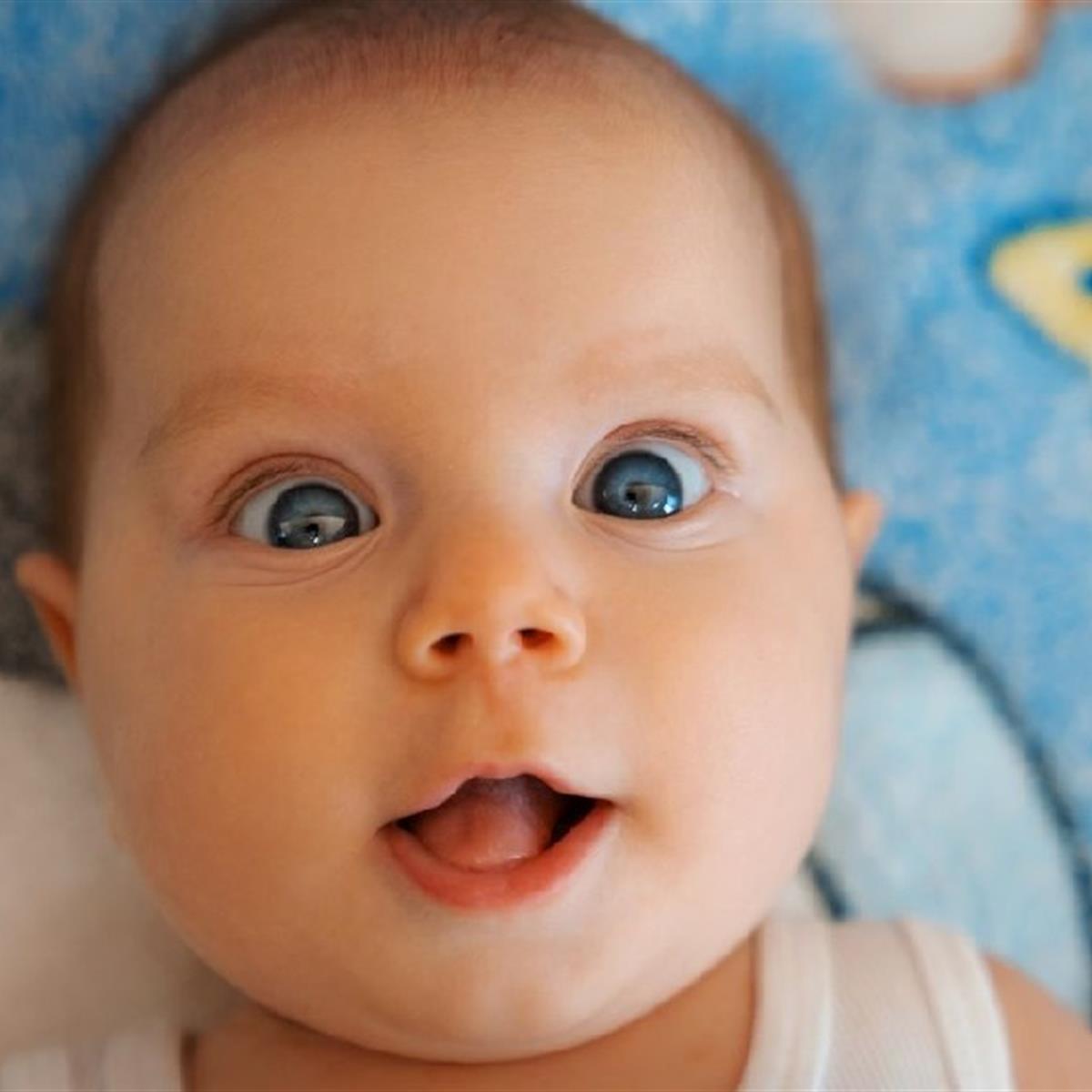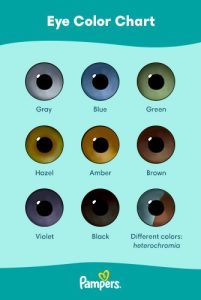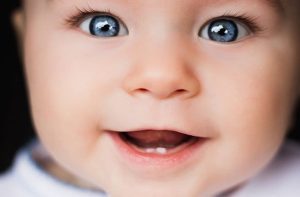Celebrating Your Baby’s Unique Traits, Embracing Individual Differences
Babies’ eye color change is a natural phenomenon that occurs in the first year of life.
By embracing these changes, we celebrate the diversity that makes each baby special.
Nurturing Self-confidence
Encourage your child to appreciate their unique features, including their eye color.
Nurturing their self-confidence fosters a healthy sense of identity.
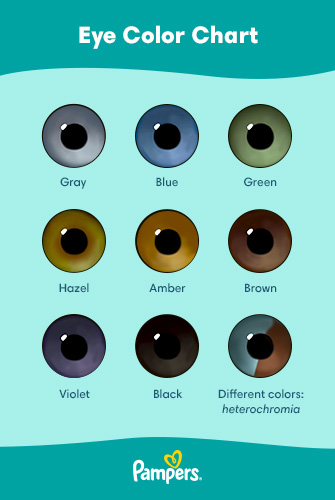
At What Age Can You Tell A Baby’s Eye Color?
You can usually tell a baby’s eye color around six to nine months of age.
Do All Newborns Have Blue Eyes?
Yes, not all newborns have blue eyes because eye color can change as they grow. It’s influenced by genetics and melanin levels.
What Eye Color Is The Rarest?
The rarest eye color is green, with only about 2% of the world’s population having it.
Which Parent Determines Eye Color?
Eye color is determined by the combined genetic contribution of both parents. The specific genes involved in eye color inheritance are not fully understood.
Conclusion
Understanding when babies’ eye color changes can be an exciting journey for new parents. Although genetics primarily determine the final eye color, it’s important to remember that eye color changes are most prominent during the first year of a baby’s life.
By observing the gradual shifts in pigmentation and acknowledging the role of genetics, parents can marvel at the awe-inspiring transformation their little ones undergo. Enjoy this remarkable transition as your baby’s eye color blossoms into its unique shade.
Development Of Eye Color In Babies, Initial Eye Color At Birth
Babies are typically born with blue or gray eyes, due to the absence of melanin.
Regardless of parents’ eye color, newborns often have light-colored irises.
Timeline For Eye Color Change
Changes in eye color can occur as early as 3 to 6 months after birth.
Final eye color is usually established by the time the baby is around 9 to 12 months old.
Common Eye Color Changes, Blue To Brown
Blue eyes in babies can gradually change to brown due to the production of melanin pigment over time.
Gray To Green
Gray eyes may evolve into green as the pigmentation in the iris continues to develop.

Cultural And Environmental Influences
The color of a baby’s eyes may change during the first year due to genetic and environmental factors. Factors like melanin production and the presence of specific genes can influence the final color of a baby’s eyes. Generally, some babies may have blue eyes that later darken as they grow.
Impact Of Sunlight
The amount of sunlight babies receive can play a role in the change of their eye color. Sunlight contains ultraviolet (UV) radiation, which can affect pigmentation. When exposed to sunlight, the pigment-producing cells in the iris, called melanocytes, may produce more melanin, resulting in a darker eye color.
One study found that babies born with blue or light-colored eyes who regularly spent time outdoors developed darker eye colors compared to those who were rarely exposed to sunlight. This suggests that sunlight can stimulate the production of melanin, leading to a change in eye color. It’s important to note that excessive exposure to the sun can be harmful to a baby’s delicate skin. To protect their skin from the sun’s harmful UV rays, it is recommended to dress them in protective clothing, use sunscreen specifically formulated for babies, and keep them in the shade during peak sun hours.
Social And Cultural Factors
In addition to biological factors, social and cultural influences can also affect the perception and expression of eye color. Different societies may have specific cultural beliefs, norms, or preferences related to eye color. For example, some cultures consider certain eye colors to be more desirable or attractive than others.
This perception can influence parents’ attitudes towards their baby’s eye color and may even impact how they describe or interpret the color. Social and cultural factors can therefore shape the way eye color change is perceived within a community or family. It’s important to remember that these cultural influences do not directly impact the biological process of eye color change.
They are merely subjective perceptions and societal preferences that can vary widely across different regions and communities. Overall, while biological factors such as genetics and melanin production are the primary drivers of eye color change in babies, cultural and environmental influences can also contribute to how eye color change is perceived and appreciated in different societies. By understanding these influences, we can gain a better appreciation for the complexity and diversity of eye colors across the world.
How To Predict Potential Changes
Babies’ eye color can change as they grow, often evolving from lighter shades to their final hue. It’s challenging to predict when this alteration will occur, as genetics and environmental factors play a role in the process.
Observing Family History
One way to predict potential changes in a baby’s eye color is to observe the family history. Look at the eye colors of both parents and other family members. While it’s not an exact science, family history can provide some indications of possible eye color changes in the baby.
Consulting Pediatricians
Another effective way to predict potential changes in a baby’s eye color is by consulting pediatricians. Pediatricians can assess the colors in the baby’s eyes and provide valuable insights based on their professional expertise. They can also offer guidance on what to expect regarding potential changes in eye color as the baby develops.
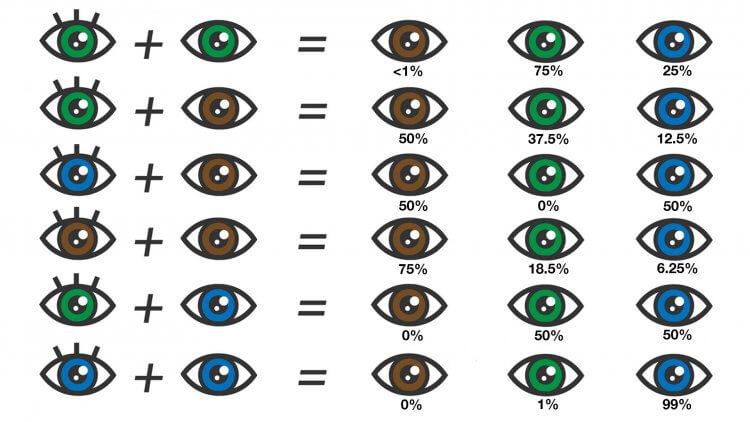
Can Eye Color Change After 6 Months?
Babies’ eye color typically stabilizes by the age of 6 months, but in some cases, it can continue to change up to 12 months of age. The final eye color is influenced by genetics and melanin production, which can continue to develop in the first year of life.
Is Heterochromia Common In Infants?
Heterochromia, a condition where the eyes are different colors, is rare in infants. It’s generally not a cause for concern unless it’s accompanied by other symptoms. Most cases of heterochromia in infants are a result of genetic factors and are not indicative of any underlying health issues.
Supporting Your Baby’s Eye Health
Babies are born with beautiful, captivating eyes that can leave us in awe. But did you know that a baby’s eye color isn’t permanent? In fact, it can change as they grow older. Understanding when and why your baby’s eye color may change can help you better support their eye health. By implementing proper eye care practices and ensuring regular check-ups, you can play a crucial role in promoting your baby’s optimal vision.
Importance Of Regular Check-ups
Regular check-ups are vital to your baby’s overall eye health. These appointments allow a healthcare professional to monitor their eye development and detect any potential issues early on. During these exams, the eye doctor examines factors such as the alignment of the eyes, the size of the pupils, and the response to light. By identifying and addressing any problems promptly, you can help prevent long-term visual impairments and ensure your baby’s eyes stay healthy.
Implementing Eye Care Practices
Implementing proper eye care practices at home can greatly contribute to your baby’s eye health. Here are some essential steps you can take:
- Ensure a clean environment
- Wash your hands before touching your baby’s eyes
- Gently clean your baby’s eyes with a soft, damp cloth
Additionally, it’s crucial to be mindful of any signs of eye discomfort or possible eye problems, such as excessive tearing, redness, or difficulty focusing. If you notice any concerning symptoms, it’s important to consult a healthcare professional promptly.
Remember, your baby’s eyes are precious and require special attention. By scheduling regular check-ups and implementing proper eye care practices, you can support your baby’s eye health and promote optimal vision development.
Celebrating Your Baby’s Unique Traits, Embracing Individual Differences
Babies’ eye color change is a natural phenomenon that occurs in the first year of life.
By embracing these changes, we celebrate the diversity that makes each baby special.
Nurturing Self-confidence
Encourage your child to appreciate their unique features, including their eye color.
Nurturing their self-confidence fosters a healthy sense of identity.

At What Age Can You Tell A Baby’s Eye Color?
You can usually tell a baby’s eye color around six to nine months of age.
Do All Newborns Have Blue Eyes?
Yes, not all newborns have blue eyes because eye color can change as they grow. It’s influenced by genetics and melanin levels.
What Eye Color Is The Rarest?
The rarest eye color is green, with only about 2% of the world’s population having it.
Which Parent Determines Eye Color?
Eye color is determined by the combined genetic contribution of both parents. The specific genes involved in eye color inheritance are not fully understood.
Conclusion
Understanding when babies’ eye color changes can be an exciting journey for new parents. Although genetics primarily determine the final eye color, it’s important to remember that eye color changes are most prominent during the first year of a baby’s life.
By observing the gradual shifts in pigmentation and acknowledging the role of genetics, parents can marvel at the awe-inspiring transformation their little ones undergo. Enjoy this remarkable transition as your baby’s eye color blossoms into its unique shade.
Inheritance Of Eye Color, Babies eye color change
Eye color is determined by a complex interplay of genetics. It’s fascinating how certain traits are passed down from parents to their children, and eye color is no exception. Understanding the genetics behind eye color can help explain why some babies’ eye colors change and others’ remain constant.
The inheritance of eye color follows a Mendelian pattern, meaning it is influenced by multiple genes. The primary gene involved in determining eye color is called OCA2, located on chromosome 15. This gene produces a protein that helps determine the amount of melanin, the pigment responsible for eye color, produced in the iris.
Additionally, other genes, such as HERC2 and TYR, play a role in eye color inheritance. These genes interact with OCA2 and influence the amount and distribution of melanin in the iris. The combination of different versions of these genes leads to the various eye colors we observe.
Factors Influencing Eye Color
While genetics play a crucial role in determining eye color, factors like ethnicity and the presence of certain genetic mutations can also influence the final eye color outcome.
One influential factor is the amount of melanin present in the iris. Melanin is responsible for the spectrum of eye colors, ranging from deep brown to light blue. Higher levels of melanin result in darker eye colors, while lower levels contribute to lighter shades.
Ethnicity also plays a role in determining eye color. For example, individuals of African or Asian descent tend to have darker eye colors, such as brown or black. On the other hand, people of European or Northern African ancestry are more likely to have lighter eye colors, including blue, green, or hazel.
It’s important to note that eye color can change during the first year of a baby’s life, regardless of the genetics involved. Many babies are born with blue or gray eyes, which later may change to brown, green, or hazel as melanin production increases. The final eye color may not become evident until around 6 to 9 months of age.
In conclusion, the genetics of eye color is a fascinating subject that involves multiple genes and their interactions. While genetics play a significant role, factors like melanin levels and ethnicity also influence the eye color outcome. It’s interesting to observe how babies’ eye colors can change during their first year, as their bodies adapt and produce more melanin.
Development Of Eye Color In Babies, Initial Eye Color At Birth
Babies are typically born with blue or gray eyes, due to the absence of melanin.
Regardless of parents’ eye color, newborns often have light-colored irises.
Timeline For Eye Color Change
Changes in eye color can occur as early as 3 to 6 months after birth.
Final eye color is usually established by the time the baby is around 9 to 12 months old.
Common Eye Color Changes, Blue To Brown
Blue eyes in babies can gradually change to brown due to the production of melanin pigment over time.
Gray To Green
Gray eyes may evolve into green as the pigmentation in the iris continues to develop.

Cultural And Environmental Influences
The color of a baby’s eyes may change during the first year due to genetic and environmental factors. Factors like melanin production and the presence of specific genes can influence the final color of a baby’s eyes. Generally, some babies may have blue eyes that later darken as they grow.
Impact Of Sunlight
The amount of sunlight babies receive can play a role in the change of their eye color. Sunlight contains ultraviolet (UV) radiation, which can affect pigmentation. When exposed to sunlight, the pigment-producing cells in the iris, called melanocytes, may produce more melanin, resulting in a darker eye color.
One study found that babies born with blue or light-colored eyes who regularly spent time outdoors developed darker eye colors compared to those who were rarely exposed to sunlight. This suggests that sunlight can stimulate the production of melanin, leading to a change in eye color. It’s important to note that excessive exposure to the sun can be harmful to a baby’s delicate skin. To protect their skin from the sun’s harmful UV rays, it is recommended to dress them in protective clothing, use sunscreen specifically formulated for babies, and keep them in the shade during peak sun hours.
Social And Cultural Factors
In addition to biological factors, social and cultural influences can also affect the perception and expression of eye color. Different societies may have specific cultural beliefs, norms, or preferences related to eye color. For example, some cultures consider certain eye colors to be more desirable or attractive than others.
This perception can influence parents’ attitudes towards their baby’s eye color and may even impact how they describe or interpret the color. Social and cultural factors can therefore shape the way eye color change is perceived within a community or family. It’s important to remember that these cultural influences do not directly impact the biological process of eye color change.
They are merely subjective perceptions and societal preferences that can vary widely across different regions and communities. Overall, while biological factors such as genetics and melanin production are the primary drivers of eye color change in babies, cultural and environmental influences can also contribute to how eye color change is perceived and appreciated in different societies. By understanding these influences, we can gain a better appreciation for the complexity and diversity of eye colors across the world.
How To Predict Potential Changes
Babies’ eye color can change as they grow, often evolving from lighter shades to their final hue. It’s challenging to predict when this alteration will occur, as genetics and environmental factors play a role in the process.
Observing Family History
One way to predict potential changes in a baby’s eye color is to observe the family history. Look at the eye colors of both parents and other family members. While it’s not an exact science, family history can provide some indications of possible eye color changes in the baby.
Consulting Pediatricians
Another effective way to predict potential changes in a baby’s eye color is by consulting pediatricians. Pediatricians can assess the colors in the baby’s eyes and provide valuable insights based on their professional expertise. They can also offer guidance on what to expect regarding potential changes in eye color as the baby develops.

Can Eye Color Change After 6 Months?
Babies’ eye color typically stabilizes by the age of 6 months, but in some cases, it can continue to change up to 12 months of age. The final eye color is influenced by genetics and melanin production, which can continue to develop in the first year of life.
Is Heterochromia Common In Infants?
Heterochromia, a condition where the eyes are different colors, is rare in infants. It’s generally not a cause for concern unless it’s accompanied by other symptoms. Most cases of heterochromia in infants are a result of genetic factors and are not indicative of any underlying health issues.
Supporting Your Baby’s Eye Health
Babies are born with beautiful, captivating eyes that can leave us in awe. But did you know that a baby’s eye color isn’t permanent? In fact, it can change as they grow older. Understanding when and why your baby’s eye color may change can help you better support their eye health. By implementing proper eye care practices and ensuring regular check-ups, you can play a crucial role in promoting your baby’s optimal vision.
Importance Of Regular Check-ups
Regular check-ups are vital to your baby’s overall eye health. These appointments allow a healthcare professional to monitor their eye development and detect any potential issues early on. During these exams, the eye doctor examines factors such as the alignment of the eyes, the size of the pupils, and the response to light. By identifying and addressing any problems promptly, you can help prevent long-term visual impairments and ensure your baby’s eyes stay healthy.
Implementing Eye Care Practices
Implementing proper eye care practices at home can greatly contribute to your baby’s eye health. Here are some essential steps you can take:
- Ensure a clean environment
- Wash your hands before touching your baby’s eyes
- Gently clean your baby’s eyes with a soft, damp cloth
Additionally, it’s crucial to be mindful of any signs of eye discomfort or possible eye problems, such as excessive tearing, redness, or difficulty focusing. If you notice any concerning symptoms, it’s important to consult a healthcare professional promptly.
Remember, your baby’s eyes are precious and require special attention. By scheduling regular check-ups and implementing proper eye care practices, you can support your baby’s eye health and promote optimal vision development.
Celebrating Your Baby’s Unique Traits, Embracing Individual Differences
Babies’ eye color change is a natural phenomenon that occurs in the first year of life.
By embracing these changes, we celebrate the diversity that makes each baby special.
Nurturing Self-confidence
Encourage your child to appreciate their unique features, including their eye color.
Nurturing their self-confidence fosters a healthy sense of identity.

At What Age Can You Tell A Baby’s Eye Color?
You can usually tell a baby’s eye color around six to nine months of age.
Do All Newborns Have Blue Eyes?
Yes, not all newborns have blue eyes because eye color can change as they grow. It’s influenced by genetics and melanin levels.
What Eye Color Is The Rarest?
The rarest eye color is green, with only about 2% of the world’s population having it.
Which Parent Determines Eye Color?
Eye color is determined by the combined genetic contribution of both parents. The specific genes involved in eye color inheritance are not fully understood.
Conclusion
Understanding when babies’ eye color changes can be an exciting journey for new parents. Although genetics primarily determine the final eye color, it’s important to remember that eye color changes are most prominent during the first year of a baby’s life.
By observing the gradual shifts in pigmentation and acknowledging the role of genetics, parents can marvel at the awe-inspiring transformation their little ones undergo. Enjoy this remarkable transition as your baby’s eye color blossoms into its unique shade.
When do babies eye color change typically changes during their first year of life. During this time, the melanin production in their iris increases, leading to a gradual shift in color.
Genetics Of Eye Color
Babies’ eye color changes usually occur during the first year, as melanin production increases. The genetics of eye color play a role in this transformation, as the initial hue may shift due to the amount and distribution of melanin. This process can lead to surprising alterations in a baby’s eye color over time.
Inheritance Of Eye Color, Babies eye color change
Eye color is determined by a complex interplay of genetics. It’s fascinating how certain traits are passed down from parents to their children, and eye color is no exception. Understanding the genetics behind eye color can help explain why some babies’ eye colors change and others’ remain constant.
The inheritance of eye color follows a Mendelian pattern, meaning it is influenced by multiple genes. The primary gene involved in determining eye color is called OCA2, located on chromosome 15. This gene produces a protein that helps determine the amount of melanin, the pigment responsible for eye color, produced in the iris.
Additionally, other genes, such as HERC2 and TYR, play a role in eye color inheritance. These genes interact with OCA2 and influence the amount and distribution of melanin in the iris. The combination of different versions of these genes leads to the various eye colors we observe.
Factors Influencing Eye Color
While genetics play a crucial role in determining eye color, factors like ethnicity and the presence of certain genetic mutations can also influence the final eye color outcome.
One influential factor is the amount of melanin present in the iris. Melanin is responsible for the spectrum of eye colors, ranging from deep brown to light blue. Higher levels of melanin result in darker eye colors, while lower levels contribute to lighter shades.
Ethnicity also plays a role in determining eye color. For example, individuals of African or Asian descent tend to have darker eye colors, such as brown or black. On the other hand, people of European or Northern African ancestry are more likely to have lighter eye colors, including blue, green, or hazel.
It’s important to note that eye color can change during the first year of a baby’s life, regardless of the genetics involved. Many babies are born with blue or gray eyes, which later may change to brown, green, or hazel as melanin production increases. The final eye color may not become evident until around 6 to 9 months of age.
In conclusion, the genetics of eye color is a fascinating subject that involves multiple genes and their interactions. While genetics play a significant role, factors like melanin levels and ethnicity also influence the eye color outcome. It’s interesting to observe how babies’ eye colors can change during their first year, as their bodies adapt and produce more melanin.
Development Of Eye Color In Babies, Initial Eye Color At Birth
Babies are typically born with blue or gray eyes, due to the absence of melanin.
Regardless of parents’ eye color, newborns often have light-colored irises.
Timeline For Eye Color Change
Changes in eye color can occur as early as 3 to 6 months after birth.
Final eye color is usually established by the time the baby is around 9 to 12 months old.
Common Eye Color Changes, Blue To Brown
Blue eyes in babies can gradually change to brown due to the production of melanin pigment over time.
Gray To Green
Gray eyes may evolve into green as the pigmentation in the iris continues to develop.

Cultural And Environmental Influences
The color of a baby’s eyes may change during the first year due to genetic and environmental factors. Factors like melanin production and the presence of specific genes can influence the final color of a baby’s eyes. Generally, some babies may have blue eyes that later darken as they grow.
Impact Of Sunlight
The amount of sunlight babies receive can play a role in the change of their eye color. Sunlight contains ultraviolet (UV) radiation, which can affect pigmentation. When exposed to sunlight, the pigment-producing cells in the iris, called melanocytes, may produce more melanin, resulting in a darker eye color.
One study found that babies born with blue or light-colored eyes who regularly spent time outdoors developed darker eye colors compared to those who were rarely exposed to sunlight. This suggests that sunlight can stimulate the production of melanin, leading to a change in eye color. It’s important to note that excessive exposure to the sun can be harmful to a baby’s delicate skin. To protect their skin from the sun’s harmful UV rays, it is recommended to dress them in protective clothing, use sunscreen specifically formulated for babies, and keep them in the shade during peak sun hours.
Social And Cultural Factors
In addition to biological factors, social and cultural influences can also affect the perception and expression of eye color. Different societies may have specific cultural beliefs, norms, or preferences related to eye color. For example, some cultures consider certain eye colors to be more desirable or attractive than others.
This perception can influence parents’ attitudes towards their baby’s eye color and may even impact how they describe or interpret the color. Social and cultural factors can therefore shape the way eye color change is perceived within a community or family. It’s important to remember that these cultural influences do not directly impact the biological process of eye color change.
They are merely subjective perceptions and societal preferences that can vary widely across different regions and communities. Overall, while biological factors such as genetics and melanin production are the primary drivers of eye color change in babies, cultural and environmental influences can also contribute to how eye color change is perceived and appreciated in different societies. By understanding these influences, we can gain a better appreciation for the complexity and diversity of eye colors across the world.
How To Predict Potential Changes
Babies’ eye color can change as they grow, often evolving from lighter shades to their final hue. It’s challenging to predict when this alteration will occur, as genetics and environmental factors play a role in the process.
Observing Family History
One way to predict potential changes in a baby’s eye color is to observe the family history. Look at the eye colors of both parents and other family members. While it’s not an exact science, family history can provide some indications of possible eye color changes in the baby.
Consulting Pediatricians
Another effective way to predict potential changes in a baby’s eye color is by consulting pediatricians. Pediatricians can assess the colors in the baby’s eyes and provide valuable insights based on their professional expertise. They can also offer guidance on what to expect regarding potential changes in eye color as the baby develops.

Can Eye Color Change After 6 Months?
Babies’ eye color typically stabilizes by the age of 6 months, but in some cases, it can continue to change up to 12 months of age. The final eye color is influenced by genetics and melanin production, which can continue to develop in the first year of life.
Is Heterochromia Common In Infants?
Heterochromia, a condition where the eyes are different colors, is rare in infants. It’s generally not a cause for concern unless it’s accompanied by other symptoms. Most cases of heterochromia in infants are a result of genetic factors and are not indicative of any underlying health issues.
Supporting Your Baby’s Eye Health
Babies are born with beautiful, captivating eyes that can leave us in awe. But did you know that a baby’s eye color isn’t permanent? In fact, it can change as they grow older. Understanding when and why your baby’s eye color may change can help you better support their eye health. By implementing proper eye care practices and ensuring regular check-ups, you can play a crucial role in promoting your baby’s optimal vision.
Importance Of Regular Check-ups
Regular check-ups are vital to your baby’s overall eye health. These appointments allow a healthcare professional to monitor their eye development and detect any potential issues early on. During these exams, the eye doctor examines factors such as the alignment of the eyes, the size of the pupils, and the response to light. By identifying and addressing any problems promptly, you can help prevent long-term visual impairments and ensure your baby’s eyes stay healthy.
Implementing Eye Care Practices
Implementing proper eye care practices at home can greatly contribute to your baby’s eye health. Here are some essential steps you can take:
- Ensure a clean environment
- Wash your hands before touching your baby’s eyes
- Gently clean your baby’s eyes with a soft, damp cloth
Additionally, it’s crucial to be mindful of any signs of eye discomfort or possible eye problems, such as excessive tearing, redness, or difficulty focusing. If you notice any concerning symptoms, it’s important to consult a healthcare professional promptly.
Remember, your baby’s eyes are precious and require special attention. By scheduling regular check-ups and implementing proper eye care practices, you can support your baby’s eye health and promote optimal vision development.
Celebrating Your Baby’s Unique Traits, Embracing Individual Differences
Babies’ eye color change is a natural phenomenon that occurs in the first year of life.
By embracing these changes, we celebrate the diversity that makes each baby special.
Nurturing Self-confidence
Encourage your child to appreciate their unique features, including their eye color.
Nurturing their self-confidence fosters a healthy sense of identity.

At What Age Can You Tell A Baby’s Eye Color?
You can usually tell a baby’s eye color around six to nine months of age.
Do All Newborns Have Blue Eyes?
Yes, not all newborns have blue eyes because eye color can change as they grow. It’s influenced by genetics and melanin levels.
What Eye Color Is The Rarest?
The rarest eye color is green, with only about 2% of the world’s population having it.
Which Parent Determines Eye Color?
Eye color is determined by the combined genetic contribution of both parents. The specific genes involved in eye color inheritance are not fully understood.
Conclusion
Understanding when babies’ eye color changes can be an exciting journey for new parents. Although genetics primarily determine the final eye color, it’s important to remember that eye color changes are most prominent during the first year of a baby’s life.
By observing the gradual shifts in pigmentation and acknowledging the role of genetics, parents can marvel at the awe-inspiring transformation their little ones undergo. Enjoy this remarkable transition as your baby’s eye color blossoms into its unique shade.

